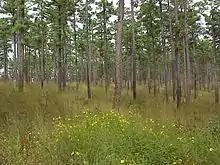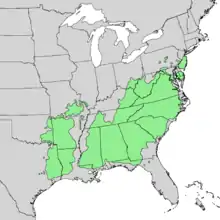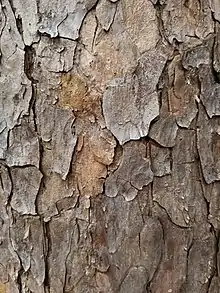Pinus echinata
Pinus echinata, the shortleaf pine,[2] is a species of pine native to the eastern United States from southernmost New York, south to northern Florida, west to eastern Oklahoma, and southwest to eastern Texas.[3] Shortleaf pine has the largest range of the southern US yellow pines, but reaches its ecological maxima around western Arkansas in the Ouachita Mountains. The tree is variable in form, sometimes straight, sometimes crooked, with an irregular crown. This tree reaches heights of 20–30 metres (65–100 ft) with a trunk diameter of 0.5–0.9 metres (1 ft 8 in–2 ft 11 in).
| Shortleaf pine | |
|---|---|
 | |
| Shortleaf Pine forest | |
| Scientific classification | |
| Kingdom: | Plantae |
| Clade: | Tracheophytes |
| Division: | Pinophyta |
| Class: | Pinopsida |
| Order: | Pinales |
| Family: | Pinaceae |
| Genus: | Pinus |
| Subgenus: | P. subg. Pinus |
| Section: | P. sect. Trifoliae |
| Subsection: | P. subsect. Australes |
| Species: | P. echinata |
| Binomial name | |
| Pinus echinata | |
 | |
| Natural range | |
The leaves are needle-like, in fascicles (bundles) of two and three mixed together, and from 7–11 cm (2 3⁄4–4 1⁄4 in) long. The cones are 4–7 cm (1 1⁄2–2 3⁄4 in) long, with thin scales with a transverse keel and a short prickle. They open at maturity but are persistent.[4] Shortleaf pine seedlings develop a persistent J-shaped crook near the ground surface.[5] Axillary and other buds form near the crook and initiate growth if the upper stem is killed by fire or is severed. It frequently hybridizes naturally with loblolly pine and pitch pine where their ranges intersect. Hybridization with loblolly pine has become increasingly frequent in recent decades and results in a loss of fire tolerance.[6]
This pine is a source of wood pulp, plywood veneer, and lumber for a variety of uses. The shortleaf pine is one of the southern US "southern yellow pines; it is also occasionally called southern yellow pine or the shortstraw pine.

This pine occupies a variety of habitats from rocky uplands to wet flood plains. With frequent fire it creates a savanna, with a very diverse under story and prime habitat for the red-cockaded woodpecker.[8]
References
- Farjon, A. (2013). "Pinus echinata". IUCN Red List of Threatened Species. 2013: e.T42359A2974993. doi:10.2305/IUCN.UK.2013-1.RLTS.T42359A2974993.en. Archived from the original on 2018-06-02.
- "Pinus echinata". Natural Resources Conservation Service PLANTS Database. USDA. Retrieved 4 October 2015.
- "Plants Profile for Pinus echinata (shortleaf pine)". plants.sc.egov.usda.gov. Retrieved 2020-09-30.
- Kral, Robert (1993). "Pinus echinata". In Flora of North America Editorial Committee (ed.). Flora of North America North of Mexico (FNA). 2. New York and Oxford – via eFloras.org, Missouri Botanical Garden, St. Louis, MO & Harvard University Herbaria, Cambridge, MA.
- Lawson, Edwin R. (1990). "Pinus echinata". In Burns, Russell M.; Honkala, Barbara H. (eds.). Conifers. Silvics of North America. Washington, D.C.: United States Forest Service (USFS), United States Department of Agriculture (USDA). 1 – via Southern Research Station (www.srs.fs.fed.us).
- Tauer, Charles G.; Stewart, John F.; Will, Rodney E.; Lilly, Curtis J.; Guldin, James M.; Nelson, C. Dana (2012-06-01). "Hybridization Leads to Loss of Genetic Integrity in Shortleaf Pine: Unexpected Consequences of Pine Management and Fire Suppression". Journal of Forestry. 110 (4): 216–224. doi:10.5849/jof.11-044. ISSN 0022-1201.
- "Silvics of Shortleaf Pine" (PDF). North Carolina Forest Service. January 2016. Archived (PDF) from the original on 2016-12-24. Retrieved 11 November 2018.
- Hedrick, Larry D.; Bukenhofer, George A.; Montague, Warren G.; Pell, William F.; Guldin, James M. (2007). "Shortleaf pine-bluestem restoration in the Ouachita National Forest". In: Shortleaf Pine Restoration and Ecology in the Ozarks: Proceedings of a Symposium: 206-213.
External links
 Media related to Pinus echinata at Wikimedia Commons
Media related to Pinus echinata at Wikimedia Commons- Gymnosperm Database: Pinus echinata
- NCRS: USDA Plants Profile: Pinus echinata
